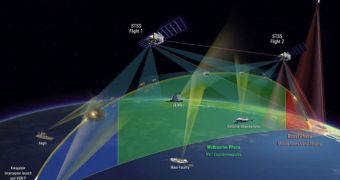The United States may in the near future benefit from a new, advanced missile-detection system, now that two demonstrations satellites have proven their worth. The instruments proved in recent tests that they are capable of detecting ground-based rocket launches with extreme accuracy, which means that the constellation they herald, called the Space Tracking and Surveillance System (STSS), will most likely become a reality.
The STSS Demonstration mission was launched about 10 months ago, and it included two spacecraft. The pair managed to pass a variety of tests while in space, including a series of vital experiments which saw them detect three separate rocket launches. The satellites proved capable of analyzing the events, and then provide data on the missile's trajectories and impact times. The system was ordered by the US Missile Defense Agency (MDA), and was constructed by the Northrop Grumman corporation and Raytheon for $1.5 billion.
“Another reliable performance by the STSS Demonstration program satellites is an encouraging development for the nation's missile defense system. The capability demonstrated by these space-based sensors is a strong indication of the value this system brings to missile defense,” explain sNorthrop Grumman's Aerospace Systems Office vice president of missile defense and missile warning programs, Gabe Watson. “It is seen as the precursor to a full-on operational system. It is a demonstration program for space based acquisition and tracking,” Northrop spokesman Bob Bishop adds for Space.
The most recent test for the satellites came on June 28, when a war scenario was played out in the US. The Army simulated that an enemy power launched a nuclear missile, so as to test its Terminal High Altitude Area Defense (THAAD) missile system. This is a vehicle that carries rockets capable of intercepting Intercontinental Ballistic Missiles (ICBM), and destroying them mid-flight. As the test was carried on, the two demonstrator satellites accurately surveyed the scene from above.

 14 DAY TRIAL //
14 DAY TRIAL //